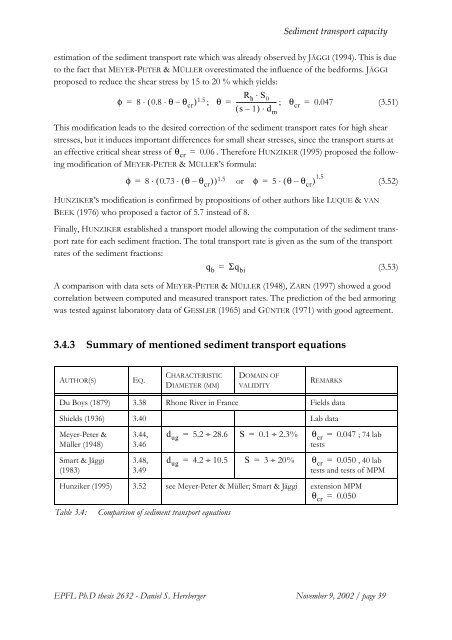pdf, 12 MiB - Infoscience - EPFL
pdf, 12 MiB - Infoscience - EPFL
pdf, 12 MiB - Infoscience - EPFL
You also want an ePaper? Increase the reach of your titles
YUMPU automatically turns print PDFs into web optimized ePapers that Google loves.
Sediment transport capacity<br />
estimation of the sediment transport rate which was already observed by JÄGGI (1994). This is due<br />
to the fact that MEYER-PETER & MÜLLER overestimated the influence of the bedforms. JÄGGI<br />
proposed to reduce the shear stress by 15 to 20 % which yields:<br />
φ 8 ( 0.8 ⋅ θ–<br />
θ cr<br />
) 1.5 R<br />
= ⋅<br />
; θ h ⋅ S<br />
= -------------------------- 0<br />
; θ (3.51)<br />
( s – 1) ⋅ d cr<br />
= 0.047<br />
m<br />
This modification leads to the desired correction of the sediment transport rates for high shear<br />
stresses, but it induces important differences for small shear stresses, since the transport starts at<br />
an effective critical shear stress of θ cr = 0.06 . Therefore HUNZIKER (1995) proposed the following<br />
modification of MEYER-PETER & MÜLLER’S formula:<br />
φ = 8 ⋅ ( 0.73⋅<br />
( θ–<br />
θ cr<br />
)) 1.5 or φ = 5 ⋅ ( θ–<br />
θ cr<br />
) 1.5<br />
(3.52)<br />
HUNZIKER’S modification is confirmed by propositions of other authors like LUQUE & VAN<br />
BEEK (1976) who proposed a factor of 5.7 instead of 8.<br />
Finally, HUNZIKER established a transport model allowing the computation of the sediment transport<br />
rate for each sediment fraction. The total transport rate is given as the sum of the transport<br />
rates of the sediment fractions:<br />
=<br />
(3.53)<br />
q b<br />
A comparison with data sets of MEYER-PETER & MÜLLER (1948), ZARN (1997) showed a good<br />
correlation between computed and measured transport rates. The prediction of the bed armoring<br />
was tested against laboratory data of GESSLER (1965) and GÜNTER (1971) with good agreement.<br />
Σq bi<br />
3.4.3 Summary of mentioned sediment transport equations<br />
AUTHOR(S)<br />
EQ.<br />
CHARACTERISTIC<br />
DIAMETER (MM)<br />
DOMAIN OF<br />
VALIDITY<br />
REMARKS<br />
Du Boys (1879) 3.38 Rhone River in France Fields data<br />
Shields (1936) 3.40 Lab data<br />
Meyer-Peter &<br />
Müller (1948)<br />
Smart & Jäggi<br />
(1983)<br />
3.44,<br />
3.46<br />
3.48,<br />
3.49<br />
d ug<br />
= 5.2 ÷ 28.6 S = 0.1 ÷ 2.3% θ cr<br />
= 0.047 ; 74 lab<br />
tests<br />
d ug<br />
= 4.2 ÷ 10.5 S = 3 ÷ 20% θ cr<br />
= 0.050 , 40 lab<br />
tests and tests of MPM<br />
Hunziker (1995) 3.52 see Meyer-Peter & Müller; Smart & Jäggi extension MPM<br />
θ cr = 0.050<br />
Table 3.4:<br />
Comparison of sediment transport equations<br />
<strong>EPFL</strong> Ph.D thesis 2632 - Daniel S. Hersberger November 9, 2002 / page 39
















